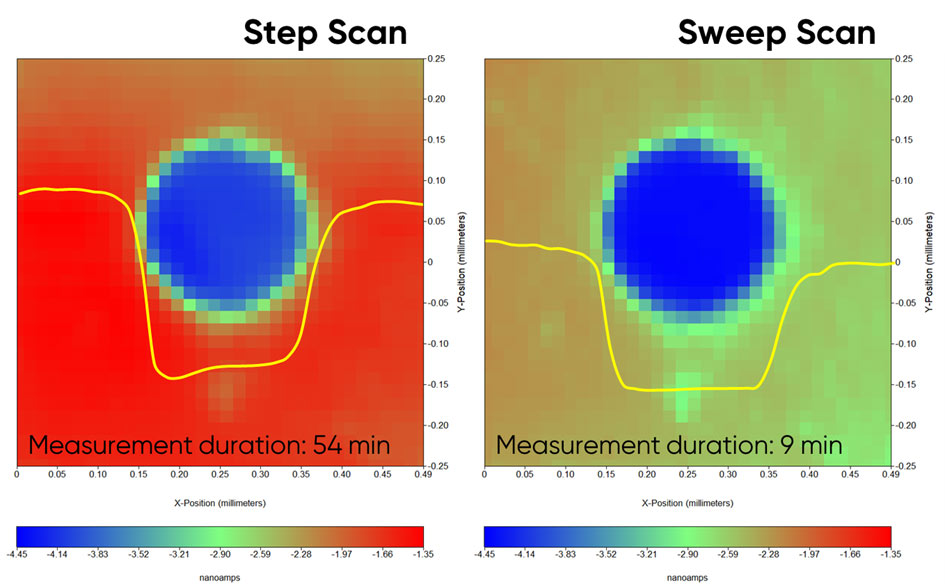How do I choose between step mode and sweep mode?
Latest updated: November 19, 2024What is the scan mode and why choose between step mode or sweep mode?
When performing scanning probe experiments of any kind, from Scanning Electrochemical Microscopy (SECM) to Atomic Force Microscopy (AFM), it is important to understand the way the probe moves during scanning, as this affects the experiment quality and duration. The way the probe moves throughout the scan is referred to as the scan mode, of which there are two distinct types: Step Scan and Sweep Scan.
Step Scan
In step scan mode the probe pauses at each point in a line to collect data. In a step scan area scan the probe will pause at the initial point in the line to collect data, it then moves to the next point, pauses, and collects data, before moving to the next point and repeating this process over, at each point until reaches the end of the line, this is illustrated in Fig. 1. Because the probe stops at each point multiple samples are measures at each point. These samples are then averaged to give the reported value at each data point. The advantage of this method is that it helps to average out any noise which could otherwise cause spurious data. Furthermore, the use of step scan, avoids any off set, or distortion of data due to the effect of scan rate. Although step scan allows for low noise, high quality data, the fact that the probe must pause at each point makes it inherently slow to perform. When using the M470 the step scan mode can be used with any technique type, however it must be used when an ac signal is of interest, as is the case for Alternating Current (ac)-SECM or Local Electrochemical Impedance Spectroscopy (LEIS), or if the Intermittent Contact (ic)-SECM technique is used.

Figure 1: The working principle of the step scan mode is illustrated.
Sweep Scan
In sweep scan mode the probe is continuously moving throughout a line, collecting data on the fly. In a sweep scan area scan the probe begins moving at the start of the line, and does not stop until it reaches the end of the line, collecting data at set time intervals throughout the line, Fig. 2. Because the velocity of the probe is well defined the time intervals can be converted to distance to allow the data to be mapped. The sweep scan experiment is inherently susceptible to external because data averaging does not occur during scanning. Furthermore, the scan rate can have an obvious effect on the quality of the final data, with fast scan rates showing measurement offset compared to slower scan rates. Careful configuration of a sweep scan experiment, however, means noise and distortions can be kept to a minimum, allowing researchers to take advantage of the sweep scan mode to allow for short experiment durations. On the M470 the sweep scan mode can only be used for dc- scanning techniques, such as Scanning Kelvin Probe (SKP), Scanning Vibrating Electrode Technique (SVET), and dc-SECM.

Figure 2: The working principle of the sweep scan mode is illustrated.
Step scan vs. sweep scan
The differences between step scan and sweep scan are directly summarized below.
Example results
An example comparison of step scan and sweep scan is shown in the SECM experiments maps in Fig. 3. In these experiments a 200 µm Au disc in resin was measured in a 5 x 10-3 mol L-1 K3[Fe(CN)6] in 0.1 mol L-1 KCl, using a 10 µm Pt SECM probe. The only difference in setup between the experiments performed was the scan mode. Using the step scan mode, the experiment took 54 minutes to complete, while using the sweep scan mode the experiment took only 9 minutes to complete. In the sweep scan experiment the current measured over the resin less negative than when measured in the step scan mode, this may be due to solution stirring, which is more likely when the sweep scan mode is used, causing convection to be a factor in the measurement.

Figure 3: A 200 µm Au disc in resin was measured in a 5 x 10-3 mol L-1 K3[Fe(CN)6] in 0.1 mol L-1 KCl, using a 10 µm Pt SECM probe. In the left-hand image, the sample was measured in step scan mode, while in the right-hand image the sample was performed in sweep scan mode. The yellow line in both images shows the x line through the center of the Au disc (Y = 45 µm), added for further comparison.





